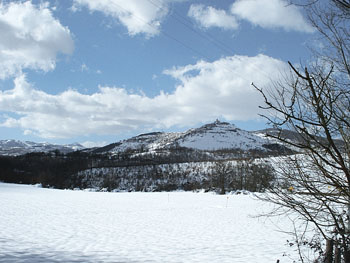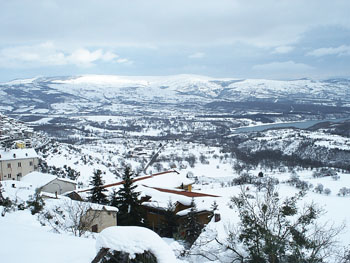The park. Natural beauties and wildlifeby Silvia Sgrosso
Grumento Nova’s area is located within the National Park, Appennino Lucano, Val d’Agri, Lagonegrese. From a naturalistic point of view, this National Park is characterized by a notable variety of environments that may be encountered. Moreover, this park represents an important connecting point and a significant ecological cross for the wildlife of the National Parks, Cilento,Vallo di Diano and Pollino. Grumento Nova is situated in the upper part of Val D’Agri, surrounded by mountain peaks and overlooking the banks of Lago di Pietra del Pertusillo, a huge artificial lake collecting the water of Agri River and its sources. The lake, set up in the late 1950s, is now highly involved and integrated in the landscape.
Along the riverside, there is the typical riparian greenery represented by mixed forests with the preponderance of Poplar (Populus alba, Populus nigra), Black alder (Alnus glutinosa) and Willow (Salix spp.).
In the lake water, at the mouth of the Agri River, groves of reeds grow, representing the ideal habitat for various animal species, especially waterfowl. Primarily among them are the White Stork (Ciconia ciconia), the Black winged Stilt (Himantopus himantopus), different species of Heron (Ardea spp.) and many other wading birds. On the lake, but not only, it’s easy to see the Black Kite (Milvus migrans) while many specimen of Red Kite (Milvus milvus) hover both over the peaks and in the valley bottom. Aquatic environments are ideal habitats in the presence of Otter (Lutra lutra), a rare and elusive Weasel, and some of its favourite prey, such as Freshwater Crayfish (Austropotamobius pallipes italicus) and Freshwater Crab (Potamobius fluviatalis), demonstrate a good conservation state of rivers and streams in this area. In the hills and valleys, you are also likely to find different species of medium size mammals such as Badger (Meles meles), Beech marten (Martes foina), Fox (Vulpes vulpes), Crested porcupine (Istrix cristata) and Hare (Lepus europaeus). Herpetofauna (reptiles and amphibians) preserve good integrity and a conspicuous number of species among which may be mentioned Italian Aesculapian snake (Zamenis lineatus), Four-lined snake (Elaphe quatuorlineata), Viper (Vipera aspis). You can also see groups of Spectacled Salamander (Salamandrina terdigitata), which represent a typical Italian Endemism (that is the phenomenon by which some animal or plant species are exclusive to a given area), and it’s quite easy to detect the presence of Apennine yellow-bellied toad (Bombina pachypus) and general True Toads in puddles of water in the valley.
Wide forests of mountainous areas, without a doubt, represent a suitable habitat for certain animal species such as the Wolf (Canis lupus), a predator of Wild Boar (Sus scrofa), than the most rare Deer (Cervus elaphus), and other small carnivorous mammals like Polecats (Mustela putorius), Martens (Martes martes) or the elusive Wildcat (Felis sylvestris). In these mountainous environments, it’s possible to observe the Peregrine falcon (Falco peregrinus) and compounds of Red-billed chough (Pyrrhocorax pyrrhocorax) together with colonies of Common raven (Corvus corax). Recent reports lead to assume a possible return of the Golden Eagle (Aquila chrysaetos), which in this area turns out to be long extinct, but sometimes frequents this area coming from the nearby Park of Pollino. Within the woods, you can hear different species of Woodpecker (Picidae); while, the presence of Eagle-owl (Bubo bubo) is rare and localized. At the top of the grasslands, you can also find colonies of Three-toed skink (Chalcides chalcides) and Slow-worms (Anguis fragilis). In the mountainous areas, there are many Apennine endemic plants of glacial origin, such as Astragalus sirinicus or the extremely localized ones, such as Vicia serinica, which live in small resorts within some of the high-mountain valleys of Sirino and Achillea lucana adverted on the ridge of Volturino. |




 In this area, it’s possible to find typical valley bottom environments such as the wonderful
In this area, it’s possible to find typical valley bottom environments such as the wonderful  From Grumento Nova’s hill and valley areas it’s possible to move toward typical mountainous environments with some of the highest peaks of southern Italy, such as
From Grumento Nova’s hill and valley areas it’s possible to move toward typical mountainous environments with some of the highest peaks of southern Italy, such as